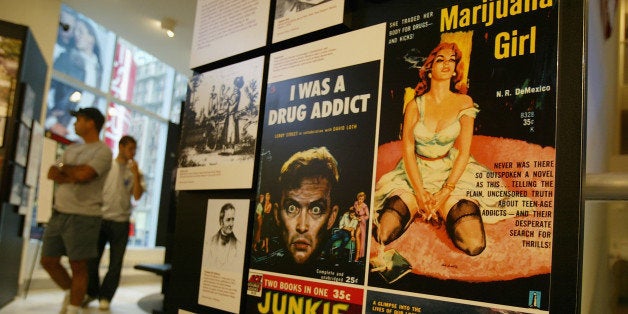
As Americans celebrate 4/20, pot culture's answer to Octoberfest, I'm getting pelted with questions about the growing legalization movement. What's the new pot like? What are you telling your kids? Right. I get those questions. But mainly I hear this one: Why is legalization happening now?
Until recently, I cited two factors. First, the emergence of the Internet offered widespread access to scientific studies and counter-narratives that debunked the government's Reefer Madness line. Second, medical marijuana served as a 20-year pilot project that calmed the fears of a worried nation. Dispensaries opened, weed was openly sold, and the pillars of civilization did not crumble.
A few days ago, I added a third factor. It came after a visit to the Drug Enforcement Administration Museum outside Washington, D.C.
The DEA Museum isn't an A-list attraction. It doesn't draw the crowds of the Smithsonian's Air and Space Museum. But the DEA's hall of history offers a fascinating glimpse into the evolution of the American drug war. (Here's a blurb for you, DEA: A must-see when you're in D.C.!)
The exhibit floor opens with a head shop from the 1970s, a metal crack-house door from the 1980s, and a medical marijuana dispensary storefront from the 2000s. This is the federal government's overview of America's drug problem. There's no meth. No heroin. No prescription pills. What defines the DEA's mission, apparently, are two parts marijuana, one part cocaine.
The main hall offers a more balanced take on history: Early folk medicines, opium dens, the "Just Say No" era, cocaine wars and pirate prescription pill operations. Fans of D.C.'s International Spy Museum will love the array of smuggling devices (hollowed-out heels, surfboards, truck tires, sedan side panels, and my favorite, an ultralight plane fitted with a cocaine carry basket).
Near the gift shop stands a gleaming motorcycle. It's displayed as an example of the asset forfeiture laws that allow the government to confiscate the property of anyone accused of a drug crime.
As much as I enjoyed seeing the trickster tools of the smuggling trade, it was that motorcycle and the mock medical marijuana dispensary that stuck in my mind. They made me realize how out-of-touch the federal government has become with the common experience of most Americans.
Asset forfeiture laws, a reasonable idea 30 years ago, have curdled into an outdated and corrupting tool of abuse. A Washington Post series last year exposed how forfeiture laws have turned too many local cops into old-fashioned highway bandits, seizing cash and cars from hapless out-of-town drivers.
Legal medical marijuana, which is apparently considered a farce by the DEA, is now accepted by 86 percent of all Americans. (53 percent support full adult legalization.) Eighty-six percent: Medical pot now outpolls the Stars and Stripes and apple pie. Many of us know someone who has benefitted from its use -- a parent with cancer, a friend fighting epilepsy, or an Iraq War soldier battling PTSD. Twenty-three states and the District of Columbia now allow it. Juries are balking at the over-prosecution of patients and growers arrested in federal raids. And yet at the DEA headquarters, a medical dispensary is still displayed next to a crack-house door.
As I exited through the gift shop, I realized I would have to add a third part to my answer. Marijuana laws are changing now because more and more voters believe the war on drugs -- and especially the war on marijuana -- has gone too far. It has grown into something irrational, ugly and downright mean. As citizens, we expect to be protected from dangerous drugs like meth, cocaine and heroin. But evidence and experience have changed our minds about marijuana. It's time the federal government caught up with us.
--
Bruce Barcott is the author of Weed The People: The Future of Legal Marijuana in America, published this month by Time Books.